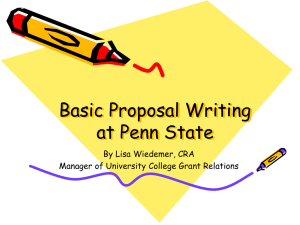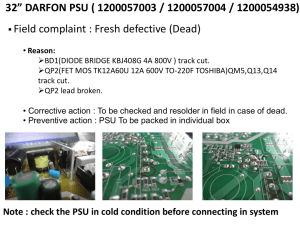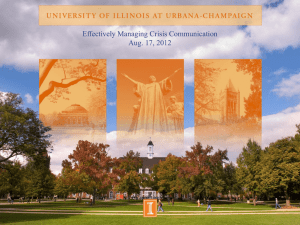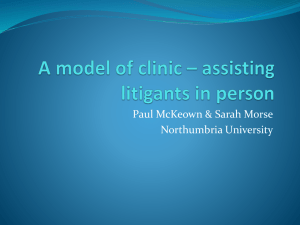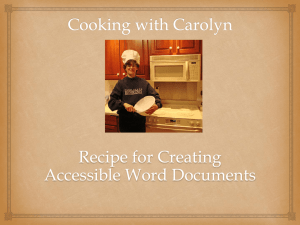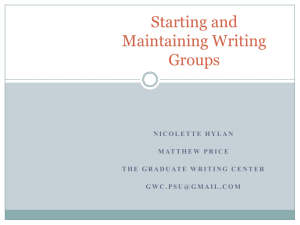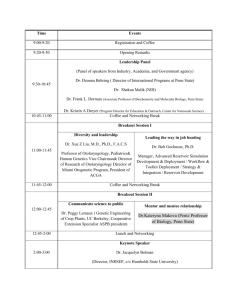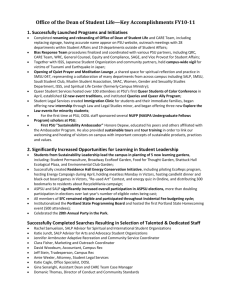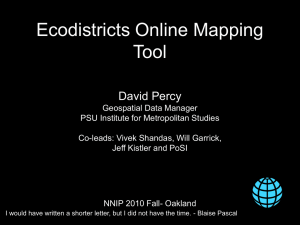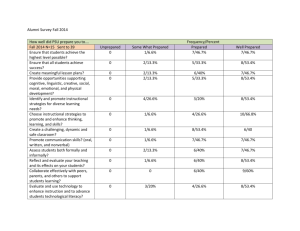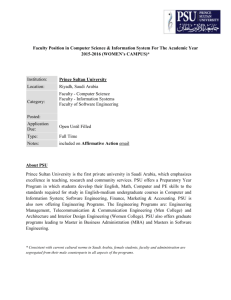Proposal-Writing 101
advertisement
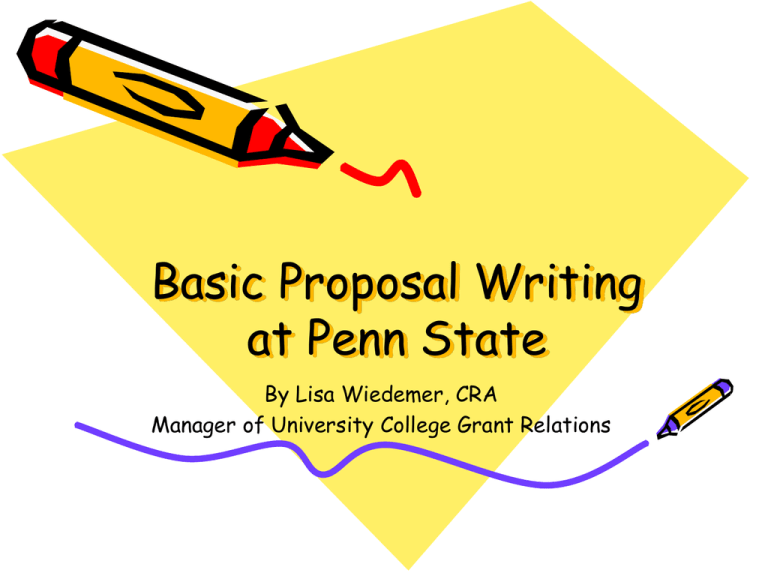
Basic Proposal Writing at Penn State By Lisa Wiedemer, CRA Manager of University College Grant Relations What we’ll be discussing • Writing your idea down – Content – Budget Writing the Proposal • Follow the guidelines exactly – Guidelines can usually be found on the web, or from the funder. Use them to craft your outline and refer to key words from the guidelines in your narrative. • Walk the fine line between being compelling and overselling • Avoid jargon – Remember—generalists and not experts may be reading your proposal. Explain jargon and acronyms. • Do not insert extraneous verbiage – Don’t be wordy! Remember the reviewers!!! Writing the Proposal Standard proposal elements • Executive summary • Statement of need • Organizational information • Project description – – – – Objectives Evaluation Timeline Budget Writing the Proposal • Executive summary – Most important proposal element because it’s usually the weed-out point. • Summarize all key points of proposal: statement of need, proposed project, funding requirements, organizational history – Keep to one page (or as guidelines indicate) – Write last • If you write it last, you’ll capture any proposal evolutions that may have occurred. Writing the Proposal • Statement of need – Brief statement of problem • Discussion of relevant literature, if appropriate • Current data corroborating need – Avoid circular reasoning • (In other words, the problem is not the lack of a solution: “We need scholarship money because we don’t have scholarship money.” Scholarship money is needed because students are lowersocioeconomic level, first generation students, non-traditional, etc.) Writing the Proposal • Organizational information, if needed – Even if not required, be sure to explain that this proposal is from a PSU undergraduate campus, not UP (to illustrate difference in student and institutional resources). – Placement in text and content depends upon guidelines • Basic information on websites – PSU: http://www.psu.edu/ur/about.html – Campuses: at individual campus websites Writing the Proposal Project description • Cover all points listed in guidelines • Remember the reviewers!!! Use: – Bullet points – Section headings – Bold face type for key words and phrases • Include: • • • • Objectives Methods Evaluation Timeline Writing the Proposal • Project Description – Objectives • Not goals! (Goals are general and not measurable) • Use measurable outcomes: – Tangible – Specific – Achievable • Rest of proposal ties directly to objectives • Can be formative or summative • Only need one or two good objectives for a proposal Writing the Proposal • Project Description – Methods • Specific activities tied to each objective • Only describe major activities per objective – How will these activities meet your objectives? – Why have you chosen these objectives? – Do they reflect the importance of your objectives? Writing the Proposal • Human or animal subjects approval: – http://www.research.psu.edu/orp • Statistical Consulting Center – Free consulting services available • Call (814) 863-0281 • E-mail scc@stat.psu.edu • Visit http://www.stat.psu.edu/~scc Writing the Proposal • Project Description – Evaluation • Describe how evaluation will occur – Internal? External? – Some funders are now recommending proposals be written around the evaluation • Commonly, evaluations either measure product or analyze process • Tied to activities • Can be formative or summative Writing the Proposal • Project Description – Timeline • Divide project into appropriate sections • Include major goals for that period of time • Include entire grant period Developing the Budget • Budget – Must relate to narrative – Elements of most budgets • • • • • Personnel Travel Materials/supplies Equipment Facilities and Administrative (Indirect) Costs Developing the Budget • Personnel – Percentage of effort • Full-time personnel salary reimbursement estimated on the percentage of time and effort needed for the project – Fringe benefits • Current rates found at: http://www.research.psu.edu/osp/commonly-requestedInformation Cost-of-living • Salaries/wages normally inflated for periods after the first year of an award. Rate changes; check OSP rate page for current one: • http://www.research.psu.edu/osp/commonly-requestedInformation Developing the Budget • Equipment – Defined as: • Unit value of $5,000 or more • Lifespan of two or more years Developing the Budget • Other Direct Costs – Services • Consultants, professional services – Printing/Copying – Materials and Supplies • Specific supplies needed for project • Computers/software generally not allowed Developing the Budget • Budget Justification/Narrative – One- or two-line descriptors explaining the item’s relevance to the project and how the figure was calculated – Must address every line item in budget Developing the Budget • Cost-sharing, or matching costs – Contact DAA as soon as possible – Often a requirement, especially of government funders • Could be: – In-kind (salary + fringe benefits, supplies or services purchased by the campus specifically for the project, etc.) – Cash (from partnering organization, campus funds, etc.) Developing the Budget • Indirect costs – Also known as Facilities and Administrative (F&A) – Usually added on top of grant request – Way for university, college and campus to recoup wear and tear, utility usage, salaries, etc., associate with administering the grant Developing the Budget • F&A Rates—negotiated with Office of Naval Research, PSU’s cognizant federal agency – Organized research – Continuing Education & Instruction • Current rates found at: http://www.research.psu.edu/osp/commonly-requestedInformation Help! • I sat through this whole thing and I STILL have questions! – Lisa Wiedemer, Manager of Grant Relations – llw13@psu.edu – (814) 865-6014 And if you need more…. • Fax number – (814) 865-3692 • Address – 111 Old Main – University Park, PA 16802

